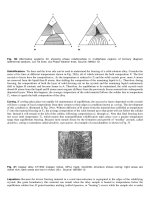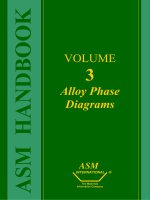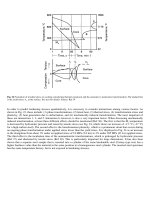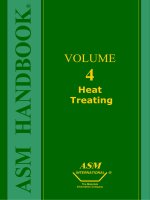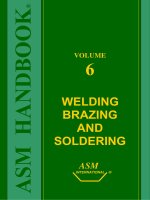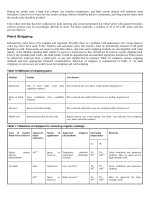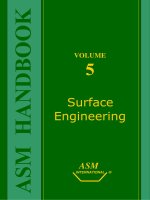Tài liệu ASM Metals HandBook P27 docx
Bạn đang xem bản rút gọn của tài liệu. Xem và tải ngay bản đầy đủ của tài liệu tại đây (988.02 KB, 40 trang )
ASM
INTERNATIONAL ®
Publication Information and Contributors
Fatigue and Fracture was published in 1996 as Volume 19 of ASM Handbook. The Volume was prepared under the
direction of the ASM International Handbook Committee.
Authors and Contributors
• PETER ANDRESEN GENERAL ELECTRIC
• BRUCE ANTOLOVICH METALLURGICAL RESEARCH CONSULTANTS, INC.
• STEPHEN D. ANTOLOVICH WASHINGTON STATE UNIVERSITY
• S. BECKER NACO TECHNOLOGIES
• C. QUINTON BOWLES UNIVERSITY OF MISSOURI
• DAVID BROEK FRACTURESEARCH
• ROBERT BUCCI ALCOA TECHNICAL CENTER
• DAVID CAMERON
• G.F. CARPENTER NACO TECHNOLOGIES
• KWAI S. CHAN SOUTHWEST RESEARCH INSTITUTE
• HANS-JÜRGEN CHRIST UNIVERSTÄT-GH-SIEGEN
• YIP-WAH CHUNG NORTHWESTERN UNIVERSITY
• JACK CRANE
• JEFF CROMPTON EDISON WELDING INSTITUTE
• DAVID L. DAVIDSON SOUTHWEST RESEARCH INSTITUTE
• S.D. DIMITRAKIS UNIVERSITY OF ILLINOIS, URBANA
• NORMAN E. DOWLING VIRGINIA POLYTECHNIC INSTITUTE
• DARLE W. DUDLEY
• ANTHONY G. EVANS HARVARD UNIVERSITY
• MORRIS FINE NORTHWESTERN UNIVERSITY
• RANDALL GERMAN PENNSYLVANIA STATE UNIVERSITY
• WILLIAM A. GLAESER BATTELLE
• J. KAREN GREGORY TECHNICAL UNIVERSITY OF MUNICH
• TODD GROSS UNIVERSITY OF NEW HAMPSHIRE
• PARMEET S. GROVER GEORGIA INSTITUTE OF TECHNOLOGY
• B. CARTER HAMILTON GEORGIA INSTITUTE OF TECHNOLOGY
• MARK HAYES THE CENTRE FOR SPRING TECHNOLOGY
• DAVID W. HOEPPNER UNIVERSITY OF UTAH
• STEPHEN J. HUDAK, JR. SOUTHWEST RESEARCH INSTITUTE
• R. SCOTT HYDE TIMKEN RESEARCH CENTER
• R. JOHANSSON AVESTA SHEFFIELD AB
• STEVE JOHNSON GEORGIA INSTITUTE OF TECHNOLOGY
• TARSEM JUTLA CATERPILLAR INC.
• MITCHELL KAPLAN WILLIS AND KAPLAN INC.
• GERHARDUS H. KOCH CC TECHNOLOGIES
• GEORGE KRAUSS COLORADO SCHOOL OF MINES
• JOHN D. LANDES UNIVERSITY OF TENNESSEE
• RONALD W. LANDGRAF VIRGINIA POLYTECHNIC INSTITUTE
• FRED LAWRENCE UNIVERSITY OF ILLINOIS, URBANA
• BRIAN LEIS BATTELLE, COLUMBUS
• JOHN LEWANDOWSKI CASE WESTERN RESERVE UNIVERSITY
• P.K. LIAW UNIVERSITY OF TENNESSEE
• JOHN W. LINCOLN WRIGHT PATTERSON AIR FORCE BASE
• ALAN LIU ROCKWELL INTERNATIONAL SCIENCE CENTER (RETIRED)
• PETR LUKÁ ACADEMY OF SCIENCE OF THE CZECH REPUBLIC
• W.W. MAENNING
• DAVID C. MAXWELL UNIVERSITY OF DAYTON RESEARCH INSTITUTE
• R. CRAIG MCCLUNG SOUTHWEST RESEARCH INSTITUTE
• DAVID L. MCDOWELL GEORGIA INSTITUTE OF TECHNOLOGY
• ARTHUR J. MCEVILY UNIVERSITY OF CONNECTICUT
• WILLIAM J. MILLS
• M.R. MITCHELL ROCKWELL INTERNATIONAL SCIENCE CENTER
• CHARLES MOYER THE TIMKEN COMPANY (RETIRED)
• CHRISTOPHER L. MUHLSTEIN GEORGIA INSTITUTE OF TECHNOLOGY
• W.H. MUNSE UNIVERSITY OF ILLINOIS, URBANA
• TED NICHOLAS UNIVERSITY OF DAYTON RESEARCH INSTITUTE
• GLENN NORDMARK ALCOA TECHNICAL CENTER (RETIRED)
• RICHARD NORRIS GEORGIA INSTITUE OF TECHNOLOGY
• PETER S. PAO NAVAL RESEARCH LABORATORY
• C.C. "BUDDY" POE NASA LANGLEY RESEARCH CENTER
• SRINIVAS RAO SELECTRON CORPORATION
• JOHN O. RATKA BRUSH WELLMAN
• K.S. RAVICHANDRAN UNIVERSITY OF UTAH
• H. REEMSNYDER BETHLEHEM STEEL
• TED REINHART BOEING COMMERCIAL AIRPLANE GROUP
• ALAN ROSENFIELD BATTELLE, COLUMBUS (RETIRED)
• ASHOK SAXENA GEORGIA INSTITUTE OF TECHNOLOGY
• JAAP SCHIJVE DELFT UNIVERSITY OF TECHNOLOGY
• HUSEYIN SEHITOGLU UNIVERSITY OF ILLINOIS, URBANA
• STEVEN SHAFFER BATTELLE, COLUMBUS
• S. SHANMUGHAM UNIVERSITY OF TENNESSEE
• E. STARKE, JR. UNIVERSITY OF VIRGINIA
• SUBRA SURESH MASSACHUSETTS INSTITUTE OF TECHNOLOGY
• THOMAS SWIFT FEDERAL AVIATION ADMINISTRATION
• ROBERT SWINDEMAN OAK RIDGE NATIONAL LABORATORY
• PETER F. TIMMINS RISK BASED INSPECTION, INC.
• JAMES VARNER ALFRED UNIVERSITY
• SEMYON VAYNMAN NORTHWESTERN UNIVERSITY
• PAUL S. VEERS SANDIA NATIONAL LABORATORY
• LOTHAR WAGNER TECHNICAL UNIVERSITY COTTBUS
• ALEXANDER D. WILSON LUKENS STEEL
• TIMOTHY A. WOLFF WILLIS & KAPLAN, INC.
• ALEKSANDER ZUBELEWICZ IBM MICROELECTRONICS
Reviewers
Editorial Review Board
• JOHN BARSOM U.S. STEEL
• J. BUNCH NORTHROP GRUMMON CORPORATION
• DIANNE CHONG MCDONNELL DOUGLAS AEROSPACE
• JOHN DELUCCIA UNIVERSITY OF PENNSYLVANIA
• J. KEITH DONALD FRACTURE TECHNOLOGY ASSOCIATES
• TIM FOECKE NATIONAL INSTITUTE OF STANDARDS AND TECHNOLOGY
• W. GERBERICH UNIVERSITY OF MINNESOTA, MINNEAPOLIS
• ALTEN F. GRANDT PURDUE UNIVERSITY
• MICHAEL T. HAHN NORTHROP GRUMMAN CORPORATION
• KEVIN HOUR BABCOCK & WILCOX
• GIL KAUFMAN THE ALUMINUM ASSOCIATION
• D.L. KLARSTROM HAYNES INTERNATIONAL INC.
• CAMPBELL LAIRD UNIVERSITY OF PENNSYLVANIA
• JAMES LANKFORD SOUTHWEST RESEARCH INSTITUTE
• DAVID MATLOCK COLORADO SCHOOL OF MINES
• NEVILLE MOODY SANDIA NATIONAL LABORATORIES
• MAREK A. PRZYSTUPA UCLA
• STANLEY ROLFE UNIVERSITY OF KANSAS
• ALAN ROSENFIELD BATTELLE, COLUMBUS (RETIRED)
• ANTONIO RUFIN BOEING COMMERCIAL AIRPLANE GROUP
• CHARLES SAFF MCDONNELL DOUGLAS AEROSPACE
• K.K. SANKAROV MCDONNELL DOUGLAS
• MICHAEL STOUT LOS ALAMOS NATIONAL LABORATORIES
• TIMOTHY TOPPER UNIVERSITY OF WATERLOO
• WILLIAM R. TYSON CANMET
• A.K. VASUDEVAN OFFICE OF NAVAL RESEARCH
• R. VISWANATHAN ELECTRIC POWER RESEARCH INSTITUTE
Reviewers
• DAVID ALEXANDER OAK RIDGE NATIONAL LABORATORY
• TOM ANGELIU GE CORPORATION R&D
• DUANE BERGMANN BERGMANN ENGINEERING, INC.
• DALE BREEN GEAR RESEARCH INSTITUTE
• ROBERT BUCCI ALCOA TECHNICAL CENTER
• HAROLD BURRIER THE TIMKEN COMPANY
• BRUCE BUSSERT LOCKHEED MARTIN
• JIM CHESNUTT GENERAL ELECTRIC
• THOMAS CROOKER
• ROBERT DEXTER LEHIGH UNIVERSITY
• J.C. EARTHMAN UNIVERSITY OF CALIFORNIA, IRVINE
• ROBERT ERRICHELLO GEARTECH
• D. EYLON UNIVERSITY OF DAYTON
• DOUG GODFREY WEAR ANALYSIS INC.
• HARRY HAGAN THE CINCINNATI GEAR COMPANY
• GARY HALFORD NASA LEWIS RESEARCH CENTER
• DAVID HOEPPNER UNIVERSITY OF UTAH
• LARRY ILCEWICZ BOEING COMMERCIAL AIRPLANE COMPANY
• GURPREET JALEWALIA MAGNESIUM ALLOY PRODUCTS COMPANY
• BRAD JAMES FAILURE ANALYSIS ASSOCIATES
• KUMAR JATA WRIGHT PATTERSON AIR FORCE BASE
• CHARLES KURKJIAN BELL COMMUNICATIONS RESEARCH
• JAMES LARSEN WRIGHT LABORATORY
• ALAN LAWLEY DREXEL UNIVERSITY
• FRED LAWRENCE UNIVERSITY OF ILLINOIS AT URBANA-CHAMPAIGN
• PETER LEE THE TIMKEN COMPANY
• WALTER LITTMANN
• JAMES MARSDEN AIR PRODUCTS AND CHEMICALS, INC.
• DAVID MCDOWELL GEORGIA INSTITUTE OF TECHNOLOGY
• CHARLES MOYER THE TIMKEN COMPANY (RETIRED)
• H. MUGHRABI INSTITUT FÜR WERKSTOFFWISSENSCHAFTEN
• JOHN MURZA THE TIMKEN COMPANY
• P. NEUMANN MAX-PLANCK-INSTITUT FÜR EISENFORSCHUNG GMBH
• JAMES NEWMAN NASA LANGLEY
• M.W. OZELTON NORTHROP GRUMMAN CORPORATION
• PHILIP PEARSON THE TORRINGTON COMPANY
• EUGENE PFAFFENBERGER ALLISON ENGINE COMPANY
• THOMAS PIWONKA UNIVERSITY OF ALABAMA
• TOM REDFIELD VI-STAR GEAR COMPANY, INC.
• JOHN RITTER UNIVERSITY OF MASSACHUSETTS
• JOHN RUSCHAU UNIVERSITY OF DAYTON RESEARCH INSTITUTE
• CHARLES SAFF MCDONNELL AIRCRAFT COMPANY
• WOLE SOBOYEJO OHIO STATE UNIVERSITY
• R. STICKLER UNIVERSITÄT WIEN
• R.L. TOBLER NATIONAL INSTITUTE OF STANDARDS & TECHNOLOGY
• MINORU TOMOZAWA RENSSELAER POLYTECHNIC INSTITUTE
• RUNE TORHAUG STANFORD UNIVERSITY
• CHON TSAI OHIO STATE UNIVERSITY
• GORDON H. WALTER CASE CORPORATION
• ROBERT WALTER BOEING DEFENSE & SPACE GROUP
• S.Y. ZAMRIK PENNSYLVANIA STATE UNIVERSITY
Foreword
The publication of this Volume marks the first time that the ASM Handbook series has dealt with fatigue and fracture as a
distinct topic. Society members and engineers involved in the research, development, application, and analysis of
engineering materials have had a long-standing interest and involvement with fatigue and fracture problems, and this
reference book is intended to provide practical and comprehensive coverage of all aspects of these subjects.
Publication of Fatigue and Fracture also marks over 50 years of continuing progress in the development and application
of modern fracture mechanics. Numerous Society members have been actively involved in this progress, which is typified
by the seminal work of George Irwin ("Fracture Dynamics," Fracturing of Metals, ASM, 1948). Since that time period,
fracture mechanics has become a vital engineering discipline that has been integrally involved in helping to prevent the
failure of essentially all types of engineered structures.
Likewise, fatigue and crack growth have also become of primary importance to the development and use of advanced
structural materials, and this Volume addresses the wide range of fundamental, as well as practical, issues involved with
these disciplines.
We believe that our readers will find this Handbook useful, instructive, and informative at all levels. We also are
especially grateful to the authors and reviewers who have made this work possible through their generous commitments
of time and technical expertise. To these contributors we offer our special thanks.
William E. Quist
President, ASM International
Michael J. DeHaemer
Managing Director, ASM International
Preface
This volume of the ASM Handbook series, Fatigue and Fracture, marks the first separate Handbook on an important
engineering topic of long-standing and continuing interest for both materials and mechanical engineers at many levels.
Fatigue and fracture, like other forms of material degradation such as corrosion and wear, are common engineering
concerns that often limit the life of engineering materials. This perhaps is illustrated best by the "Directory of Examples
of Failure Analysis" contained in Volume 10 of the 8th Edition Metals Handbook. Over a third of all examples listed in
that directory are fatigue failures, and well over half of all failures are related to fatigue, brittle fracture, or
environmentally-assisted crack growth.
The title Fatigue and Fracture also represents the decision to include fracture mechanics as an integral part in
characterizing and understanding not only ultimate fracture but also "subcritical" crack growth processes such as fatigue.
The development and application of fracture mechanics has steadily progressed over the last 50 years and is a field of
long-standing interest and involvement by ASM members. This perhaps is best typified by the seminal work of George
Irwin in Fracturing of Metals (ASM, 1948), which is considered by many as the one of the key beginnings of modern
fracture mechanics based from the foundations established by Griffith at the start of this century.
This Handbook has been designed as a resource for basic concepts, alloy property data, and the testing and analysis
methods used to characterize the fatigue and fracture behavior of structural materials. The overall intent is to provide
coverage for three types of readers: i) metallurgists and materials engineers who need general guidelines on the practical
implications of fatigue and fracture in the selection, analysis or application structural materials; ii) mechanical engineers
who need information on the relative performance and the mechanistic basis of fatigue and fracture resistance in
materials; and iii) experts seeking advanced coverage on the scientific and engineering models of fatigue and fracture.
Major emphasis is placed on providing a multipurpose reference book for both materials and mechanical engineers with
varying levels of expertise. For example, several articles address the basic concepts for making estimates of fatigue life,
which is often necessary when data are not available for a particular alloy condition, product configuration, or stress
conditions. This is further complemented with detailed coverage of fatigue and fracture properties of ferrous, nonferrous,
and nonmetallic structural materials. Additional attention also is given to the statistical aspects of fatigue data, the
planning and evaluation of fatigue tests, and the characterization of fatigue mechanisms and crack growth.
Fracture mechanics is also thoroughly covered in Section 4, from basic concepts to detailed applications for damage
tolerance, life assessment, and failure analysis. The basic principles of fracture mechanics are introduced with a minimum
of mathematics, followed by practical introductions on the fracture resistance of structural materials and the current
methods and requirements for fracture toughness testing. Three authoritative articles further discuss the use of fracture
mechanics in fracture control, damage tolerance analysis, and the determination of residual strength in metallic structures.
Emphasis is placed on linear-elastic fracture mechanics, although the significance of elastic-plastic fracture mechanics is
adequately addressed in these key articles.
Further coverage is devoted to practical applications and examples of fracture control in weldments, process piping,
aircraft systems, failure analysis, and more advanced topics such as high-temperature crack growth and thermo-
mechanical fatigue. Extensive fatigue and fracture property data are provided in Sections 5 through 7, and the Appendices
include a detailed compilation of fatigue strength parameters and an updated summary of commonly used stress-intensity
factors.
Once again, completion of this challenging project under the auspices of the Handbook Committee is made possible by
the time and patience of authors who have contributed their work. Their efforts are greatly appreciated along with the
guidance from reviewers and the Editorial Review Board.
S. Lampman
Technical Editor
General Information
Officers and Trustees of ASM International (1995-1996)
Officers
• WILLIAM E. QUIST PRESIDENT AND TRUSTEE BOEING COMMERCIAL AIRPLANE
GROUP
• GEORGE KRAUSS VICE PRESIDENT AND TRUSTEE COLORADO SCHOOL OF MINES
• MICHAEL J. DEHAEMER SECRETARY AND MANAGING DIRECTOR ASM
INTERNATIONAL
• THOMAS F. MCCARDLE TREASURER KOLENE CORPORATION
• JOHN V. ANDREWS IMMEDIATE PAST PRESIDENT ALLVAC
Trustees
• AZIZ I. ASPHAHANI CARUS CHEMICAL COMPANY
• NICHOLAS F. FIORE CARPENTER TECHNOLOGY CORPORATION
• MERTON C. FLEMINGS MASSACHUSETTS INSTITUTE OF TECHNOLOGY
• LINDA L. HORTON LOCKHEED MARTIN ENERGY RESEARCH OAK RIDGE NATIONAL
LABORATORY
• ASH KHARE NATIONAL FORGE COMPANY
• KISHOR M. KULKARNI ADVANCED METALWORKING PRACTICES INC.
• BHAKTA B. RATH U.S. NAVAL RESEARCH LABORATORY
• DARRELL W. SMITH MICHIGAN TECHNOLOGICAL UNIVERSITY
• WILLIAM WALLACE NATIONAL RESEARCH COUNCIL CANADA INSTITUTE FOR
AEROSPACE RESEARCH
Members of the ASM Handbook Committee (1995-1996)
• WILLIAM L. MANKINS (CHAIR 1994-; MEMBER 1989-) INCO ALLOYS
INTERNATIONAL INC.
• MICHELLE M. GAUTHIER (VICE CHAIR 1994-; MEMBER 1990-) RAYTHEON
COMPANY
• BRUCE P. BARDES (1993-) MIAMI UNIVERSITY
• RODNEY R. BOYER (1982-1985; 1995-) BOEING COMMERCIAL AIRPLANE GROUP
• TONI M. BRUGGER (1993-) CARPENTER TECHNOLOGY
• ROSALIND P. CHESLOCK (1994-) ASHURST TECHNOLOGY CENTER INC.
• CRAIG V. DARRAGH (1989-) THE TIMKEN COMPANY
• RUSSELL E. DUTTWEILER (1993-) R&D CONSULTING
• AICHA ELSHABINI-RIAD (1990-) VIRGINIA POLYTECHNIC INSTITUTE & STATE
UNIVERSITY
• HENRY E. FAIRMAN (1993-)
• MICHAEL T. HAHN (1995-) NORTHROP GRUMMAN CORPORATION
• LARRY D. HANKE (1994-) MATERIALS EVALUATION AND ENGINEERING
• DENNIS D. HUFFMAN (1982-) THE TIMKEN COMPANY
• S. JIM IBARRA, JR. (1991-) AMOCO CORPORATION
• DWIGHT JANOFF (1995-) LOCKHEED MARTIN ENGINEERING AND SCIENCES
COMPANY
• PAUL J. KOVACH (1995-) STRESS ENGINEERING SERVICES INC.
• PETER W. LEE (1990-) THE TIMKEN COMPANY
• ANTHONY J. ROTOLICO (1993-) ENGELHARD SURFACE TECHNOLOGY
• MAHI SAHOO (1993-) CANMET
• WILBUR C. SIMMONS (1993-) ARMY RESEARCH OFFICE
• KENNETH B. TATOR (1991-) KTA-TATOR INC.
• MALCOLM THOMAS (1993-) ALLISON ENGINE COMPANY
• JEFFREY WALDMAN (1995-) DREXEL UNIVERSITY
Previous Chairmen of the ASM Handbook Committee
• R.S. ARCHER (1940-1942) (MEMBER 1937-1942)
• R.J. AUSTIN (1992-1994) (MEMBER 1984-)
• L.B. CASE (1931-1933) (MEMBER 1927-1933)
• T.D. COOPER (1984-1986) (MEMBER 1981-1986)
• E.O. DIXON (1952-1954) (MEMBER 1947-1955)
• R.L. DOWDELL (1938-1939) (MEMBER 1935-1939)
• J.P. GILL (1937) (MEMBER 1934-1937)
• J.D. GRAHAM (1966-1968) (MEMBER 1961-1970)
• J.F. HARPER (1923-1926) (MEMBER 1923-1926)
• C.H. HERTY, JR. (1934-1936) (MEMBER 1930-1936)
• D.D. HUFFMAN (1986-1990) (MEMBER 1982-)
• J.B. JOHNSON (1948-1951) (MEMBER 1944-1951)
• L.J. KORB (1983) (MEMBER 1978-1983)
• R.W.E. LEITER (1962-1963) (MEMBER 1955-1958, 1960-1964)
• G.V. LUERSSEN (1943-1947) (MEMBER 1942-1947)
• G.N. MANIAR (1979-1980) (MEMBER 1974-1980)
• J.L. MCCALL (1982) (MEMBER 1977-1982)
• W.J. MERTEN (1927-1930) (MEMBER 1923-1933)
• D.L. OLSON (1990-1992) (MEMBER 1982-1988, 1989-1992)
• N.E. PROMISEL (1955-1961) (MEMBER 1954-1963)
• G.J. SHUBAT (1973-1975) (MEMBER 1966-1975)
• W.A. STADTLER (1969-1972) (MEMBER 1962-1972)
• R. WARD (1976-1978) (MEMBER 1972-1978)
• M.G.H. WELLS (1981) (MEMBER 1976-1981)
• D.J. WRIGHT (1964-1965) (MEMBER 1959-1967)
Staff
ASM International staff who contributed to the development of the Volume included Steven R. Lampman, Technical
Editor; Grace M. Davidson, Manager of Handbook Production; Faith Reidenbach, Chief Copy Editor; Randall L. Boring,
Production Coordinator; Amy Hammel, Editorial Assistant; and Scott D. Henry, Manager of Handbook Development.
Editorial assistance was provided by Nikki DiMatteo, Kathleen S. Dragolich, Kelly Ferjutz, Heather Lampman, Kathleen
Mills, and Mary Jane Riddlebaugh. The Volume was prepared under the direction of William W. Scott, Jr., Director of
Technical Publications.
Conversion to Electronic Files
ASM Handbook, Volume 19, Fatigue and Fracture was converted to electronic files in 1998. The conversion was based
on the Second printing (1997). No substantive changes were made to the content of the Volume, but some minor
corrections and clarifications were made as needed.
ASM International staff who contributed to the conversion of the Volume included Sally Fahrenholz-Mann, Bonnie
Sanders, Marlene Seuffert, Gayle Kalman, Scott Henry, Robert Braddock, Alexandra Hoskins, and Erika Baxter. The
electronic version was prepared under the direction of William W. Scott, Jr., Technical Director, and Michael J.
DeHaemer, Managing Director.
Copyright Information (for Print Volume)
Copyright © 1996 by ASM International®
All rights reserved
No part of this book may be reproduced, stored in a retrieval system, or transmitted, in any form or by any means,
electronic, mechanical, photocopying, recording, or otherwise, without the written permission of the copyright owner.
First printing, December 1996
Second printing, November 1997
This book is a collective effort involving hundreds of technical specialists. It brings together a wealth of information from
world-wide sources to help scientists, engineers, and technicians solve current and long-range problems.
Great care is taken in the compilation and production of this Volume, but it should be made clear that NO
WARRANTIES, EXPRESS OR IMPLIED, INCLUDING, WITHOUT LIMITATION, WARRANTIES OF
MERCHANTABILITY OR FITNESS FOR A PARTICULAR PURPOSE, ARE GIVEN IN CONNECTION WITH
THIS PUBLICATION. Although this information is believed to be accurate by ASM, ASM cannot guarantee that
favorable results will be obtained from the use of this publication alone. This publication is intended for use by persons
having technical skill, at their sole discretion and risk. Since the conditions of product or material use are outside of
ASM's control, ASM assumes no liability or obligation in connection with any use of this information. No claim of any
kind, whether as to products or information in this publication, and whether or not based on negligence, shall be greater in
amount than the purchase price of this product or publication in respect of which damages are claimed. THE REMEDY
HEREBY PROVIDED SHALL BE THE EXCLUSIVE AND SOLE REMEDY OF BUYER, AND IN NO EVENT
SHALL EITHER PARTY BE LIABLE FOR SPECIAL, INDIRECT OR CONSEQUENTIAL DAMAGES WHETHER
OR NOT CAUSED BY OR RESULTING FROM THE NEGLIGENCE OF SUCH PARTY. As with any material,
evaluation of the material under enduse conditions prior to specification is essential. Therefore, specific testing under
actual conditions is recommended.
Nothing contained in this book shall be construed as a grant of any right of manufacture, sale, use, or reproduction, in
connection with any method, process, apparatus, product, composition, or system, whether or not covered by letters
patent, copyright, or trademark, and nothing contained in this book shall be construed as a defense against any alleged
infringement of letters patent, copyright, or trademark, or as a defense against liability for such infringement.
Comments, criticisms, and suggestions are invited, and should be forwarded to ASM International.
Library of Congress Cataloging-in-Publication Data (for Print Volume)
ASM Handbook.
Fatigue and fracture / prepared under the direction of the ASM International Handbook Committee.
Includes bibliographical references and index.
1. Fracture mechanics--Handbooks, manuals, etc.
2. Materials-Fatigue--Handbooks, manuals, etc.
I. ASM International. Handbook Committee.
II. ASM Handbook
TA409.F35 1996 620.1'126 96-47310
ISBN 0-87170-385-8
SAN 204-7586
Printed in the United States of America
Industrial Significance of Fatigue Problems
David W. Hoeppner, Department of Mechanical Engineering, The University of Utah
Introduction
THE DISCOVERY of fatigue occurred in the 1800s when several investigators in Europe observed that bridge and
railroad components were cracking when subjected to repeated loading. As the century progressed and the use of metals
expanded with the increasing use of machines, more and more failures of components subjected to repeated loads were
recorded. By the mid 1800s A. Wohler (Ref 1) had proposed a method by which the failure of components from repeated
loads could be mitigated, and in some cases eliminated. This method resulted in the stress-life response diagram approach
and the component test model approach to fatigue design.
Undoubtedly, earlier failures from repeated loads had resulted in failures of components such as clay pipes, concrete
structures, and wood structures, but the requirement for more machines made from metallic components in the late 1800s
stimulated the need to develop design procedures that would prevent failures from repeated loads of all types of
equipment. This activity was intensive from the mid-1800s and is still underway today. Even though much progress has
been made, developing design procedures to prevent failure from the application of repeated loads is still a daunting task.
It involves the interplay of several fields of knowledge, namely materials engineering, manufacturing engineering,
structural analysis (including loads, stress, strain, and fracture mechanics analysis), nondestructive inspection and
evaluation, reliability engineering, testing technology, field repair and maintenance, and holistic design procedures. All of
these must be placed in a consistent design activity that may be referred to as a fatigue design policy. Obviously, if other
time-related failure modes occur concomitantly with repeated loads and interact synergistically, then the task becomes
even more challenging. Inasmuch as humans always desire to use more goods and place more demands on the things we
can design and produce, the challenge of fatigue is always going to be with us.
Until the early part of the 1900s, not a great deal was known about the physical basis of fatigue. However, with the advent
of an increased understanding of materials, which accelerated in the early 1900s, a great deal of knowledge has been
developed about repeated load effects on engineering materials. The procedures that have evolved to deal with repeated
loads in design can be reduced to four:
• The stress-life approach
• The strain-life approach
• The fatigue-crack propagation approach (part of a larger design activity that has become known as the
damage-tolerant approach)
• The component test model approach
Reference
1. A. WOHLER, Z. BAUW, VOL 10, 1860, P 583
What is Fatigue?
Fatigueis a technical term that elicits a degree of curiosity. When citizens read or hear in their media of another fatigue
failure, they wonder whether this has something to do with getting tired or "fatigued" as they know it. Such is not the
case.
One way to explain fatigue is to refer to the ASTM standard definitions on fatigue, contained in ASTM E 1150. It is
difficult, if not impossible, to carry on intelligent conversations if discussions on fatigue do not use a set of standard
definitions such as E 1150. Within E 1150, there are over 75 terms defined, including the term fatigue: "fatigue (Note 1):
the process of progressive localized permanent structural change occurring in a material subjected to conditions that
produce fluctuating stresses and strains at some point or points and that may culminate in cracks or complete fracture
after a sufficient number of fluctuations (Note 2). Note 1--In glass technology static tests of considerable duration are
called `static fatigue' tests, a type of test generally designated as stress-rupture. Note 2--Fluctuations may occur both in
load and with time (frequency) as in the case of `random vibration'." (Ref 2).
The words in italics (emphasis added) are viewed as key words in the definition. These words are important perspectives
on the phenomenon of fatigue:
• Process
• Progressive
• Localized
• Permanent structural change
• Fluctuating stresses and strains
• Point or points
• Cracks or complete fracture
The idea that fatigue is a process is critical to dealing with it in design and to the characterization of materials as part of
design. In fact, this idea is so critical that the entire conceptual view of fatigue is affected by it! Another critical idea is the
idea of fluctuating stresses and strains. The need to have fluctuating (repeated or cyclic) stresses acting under either
constant amplitude or variable amplitude is critical to fatigue. When a failure is analyzed and attributed to fatigue, the
only thing known at that point is that the loads (the stresses/strains) were fluctuating. Nothing is necessarily known about
the nucleation of damage that forms the origin of fatigue cracks.
Reference cited in this section
2. ASTM E 1150-1987, Standard Definitions of Fatigue, 1995 Annual Book of Standards, ASTM, 1995, p 753-
762
Design for Fatigue Prevention
In design for fatigue and damage tolerance, one of two initial assumptions is often made about the state of the material.
Both of these are related to the need to invoke continuum mechanics to make the stress/strain/fracture mechanics analysis
tractable:
• The material is an ideal homogeneous, continuous, isotropic continuum that is free of defects or flaws.
• The material is an ideal homogeneous, isotropic continuum but contains an ideal cracklike discontinuity
that may or may not be considered a defect or flaw, depending on the entire design approach.
The former assumption leads to either the stress-life or strain-life fatigue design approach. These approaches are typically
used to design for finite life or "infinite life." Under both assumptions, the material is considered to be free of defects,
except insofar as the sampling procedure used to select material test specimens may "capture" the probable "defects"
when the specimen locations are selected for fatigue tests. This often has proved to be an unreliable approach and has led,
at least in part, to the damage-tolerant approach.
Another possible difficulty with these assumptions is that inspectability and detectability are not inherent parts of the
original design approach. Rather, past and current experience guide field maintenance and inspection procedures, if and
when they are considered.
The damage-tolerant approach is used to deal with the possibility that a crack-like discontinuity (or multiple ones) will
escape detection in either the initial product release or field inspection practices. Therefore, it couples directly to
nondestructive inspection (NDI) and evaluation (NDE). In addition, the potential for initiation of crack propagation must
be considered an integral part of the design process, and the subcritical crack growth characteristics under monotonic,
sustained, and cyclic loads must be incorporated in the design. The final instability parameter, such as plane strain
fracture toughness (K
Ic
), also must be incorporated in design. The damage-tolerant approach is based on the ability to
track the damage throughout the entire life cycle of the component/system. It therefore requires extensive knowledge of
the above issues, and it also requires that fracture (or damage) mechanics models be available to assist in the evaluation of
potential behavior. As well, material characterization procedures are needed to ensure that valid evaluation of the required
material "property" or response characteristic is made. NDI must be performed to ensure that probability-of-detection
determinations are made for the NDI procedure(s) to be used. This approach has proved to be reliable, especially for
safety-critical components.
The above approaches often are used in a complementary sense in fatigue design. The details of all three approaches are
discussed in this Volume.
The fatigue process has proved to be very difficult to study. Nonetheless, extensive progress on understanding the phases
of fatigue has been made in the last 100 years or so. It now is generally agreed that four distinct phases of fatigue may
occur (Ref 3, 4):
• Nucleation
• Structurally dependent crack propagation (often called the "short crack" or "small crack" phase)
• Crack propagation that is characterizable by either linear elastic fracture mechanics, elastic-plastic
fracture mechanics, or fully plastic fracture mechanics
• Final instability
Each of these phases is an extremely complex process (or may involve several processes) in and of itself. For example,
the nucleation of "fatigue" cracks is extremely difficult to study, and even "pure fatigue" mechanisms can be very
dependent on the intrinsic makeup of the material. Obviously, when one decides to pursue the nucleation of cracks in a
material, one has already either assumed that the material is crack-free or has proved it! The assumption is the easier path
and the one most often taken. When extraneous influences are involved in nucleation, such as temperature effects (e.g.,
creep), corrosion of all types, or fretting, the problem of modeling the damage is formidable. In recent years, more
research has been done on the latter issues, and models for this phase of life are beginning to emerge.
References cited in this section
3. D.W. Hoeppner, Estimation of Component Life by Application of Fatigue Crack Growth Threshold
Knowledge, Fatigue, Creep, and Pressure Vessels for Elevated Temperature Service, MPC-17, ASME,
1981, p 1-85
4. D.W. Hoeppner, Parameters That Input to Application of Damage Tolerant Concepts to Critical Engine
Components invited keynote paper, Damage Tolerance Concepts for Critical Engine Components, AGARD-
CP-393, NATO-AGARD, 1985
Industrial Significance
There is little doubt that fatigue plays a significant role in all industrial design applications. Many components are
subjected to some form of fluctuating stress/strain, and thus fatigue potentially plays a role in all such cases. However, it
is still imperative that all designs consider those aspects of nucleation processes other than fatigue that may act to nucleate
cracks that could propagate under the influence of cyclic loads. The intrinsic state of the material and all potential sources
of cracks must also be evaluated.
Nonetheless, fatigue is a significant and often a critical factor in the testing, analysis, and design of engineering materials
for machines, structures, aircraft, and power plants. An important engineering advance of this century is also the transfer
of the multi-stage fatigue process from the field to the laboratory. In order to study, explain, and qualify component
designs, or to conduct failure analyses, a key engineering step is often the simulation of the problem in the laboratory.
Any simulation is, of course, a compromise of what is practical to quantify, but the study of the multi-stage fatigue
process has been greatly advanced by the combined methods of strain-control testing and the development fracture
mechanics of fatigue crack growth rates. This combined approach (Fig. 1) is a key advance that allows better
understanding and simulation of both crack nucleation in regions of localized strain and the subsequent crack growth
mechanisms outside the plastic zone. This integration of fatigue and fracture mechanics has had important implications in
many industrial applications for mechanical and materials engineering.
Fig. 1 Laboratory simulation of the multi-stage fatigue process. Source: Ref 5
Reference cited in this section
5. L.F. Coffin, Fatigue in Machines and Structures, Fatigue and Microstructure, American Society for Metals,
1979
References
1. A. Wohler, Z. Bauw, Vol 10, 1860, p 583
2. ASTM E 1150-1987, Standard Definitions of Fatigue, 1995 Annual Book of Standards, ASTM, 1995, p 753-
762
3. D.W. Hoeppner, Estimation of Component Life by Application of Fatigue Crack Growth Threshold
Knowledge, Fatigue, Creep, and Pressure Vessels for Elevated Temperature Service, MPC-17, ASME,
1981, p 1-85
4. D.W. Hoeppner, Parameters That Input to Application of Damage Tolerant Concepts to Critical Engine
Components invited keynote paper, Damage Tolerance Concepts for Critical Engine Components, AGARD-
CP-393, NATO-AGARD, 1985
5. L.F. Coffin, Fatigue in Machines and Structures, Fatigue and Microstructure, American Society for Metals,
1979
Fracture and Structure
C. Quinton Bowles, University of Missouri-Columbia/Kansas City
Introduction
IT IS DIFFICULT to identify exactly when the problems of failure of structural and mechanical equipment became of
critical importance; however, it is clear that failures that cause loss of life have occurred for over 100 years (Ref 1, 2).
Throughout the 1800s bridges fell and pressure vessels blew up, and in the late 1800s railroad accidents in the United
Kingdom were continually reported as "The most serious railroad accident of the week"! Those in the United States also
have heard the hair-raising stories of the Liberty ships built during World War II. Of 4694 ships considered in the final
investigation, 24 sustained complete fracture of the strength deck, and 12 ships were either lost or broke in two. In this
case, the need for tougher structural steel was even more critical because welded construction was used in shipbuilding
instead of riveted plate. In riveted plate construction, a running crack must reinitiate every time it runs out of a plate. In
contrast, a continuous path is available for brittle cracking in a welded structure, which is why low notch toughness is a
more critical factor for long brittle cracks in welded ships.
Similar long brittle cracks are less likely or rare in riveted ships, which were predominant prior to welded construction.
Nonetheless, even riveted ships have provided historical examples of long brittle fracture due, in part, from low
toughness. In early 1995, for example, the material world was given the answer to an old question, "What was the
ultimate cause of the sinking of the Titanic?" True, the ship hit an iceberg, but it now seems clear that because of brittle
steel, "high in sulfur content even for its time" (Ref 3), an impact which would clearly have caused damage, perhaps
would not have resulted in the ultimate separation of the Titanic in two pieces where it was found in 1985 by
oceanographer Bob Ballard. During the undersea survey of the sunken vessel with Soviet Mir submersibles, a small piece
of plate was retrieved from 12,612 feet below the ocean's surface. Examination by spectroscopy revealed a high sulfur
content, and a Charpy impact test revealed the very brittle nature of the steel (Ref 3). However, there was some concern
that the high sulfur content was, in some way, the result of eighty years on the ocean floor at 6,000 psi pressures.
Subsequently, the son of a 1911 shipyard worker remembered a rivet hole plug which his father had saved as a memento
of his work on the Titanic. Analysis of the plug revealed the same level of sulfur exibited by the plate from the ocean
floor. In the years following the loss of the Titanic metallurgists have become well aware of the detrimental effect of high
sulfur content on fracture.
There are numerous other historical examples where material toughness was inadequate for design. The failures of cast
iron rail steel for engine loads in the 1800s is one example. A large body of scientific folklore has arisen to explain
structural material failures, almost certainly caused by a lack of tools to investigate the failures. The author was recently
startled to read on article on the building of the Saint Lawrence seaway that described the effect of temperature on
equipment: "The crawler pads of shovels and bulldozers subject to stress cracked and crumbled. Drive chains flew apart,
cables snapped and fuel lines iced up. . .And anything made of metal, especially cast metal, was liable to crystallize and
break into pieces (Ref 4). It is difficult to realize that there still exists a concept of metal crystallization as a result of
deformation that in turn leads to failure. Clearly, the development of fluorescence and diffraction x-ray analysis,
transmission and scanning electron microscopes, high-quality optical microscopy, and numerous other analytical
instruments in the last 75 years has allowed further development of dislocation theory and clarification of the mechanisms
of deformation and fracture at the atomic level.
During the postwar period, predictive models for fracture control also were pursued at the engineering level from the
work of Griffith, Orowan, and Irwin. Since the paper of Griffith in 1920 (Ref 5, 6) and the extensions of his basic theory
by Irwin (Ref 7) and others, we have come to realize that the design of structures and machines can no longer under all
conditions be based on the elastic limit or yield strength. Griffith's basic theory is applicable to all fractures in which the
energy required to make the new surfaces can be supplied from the store of energy available as potential energy, in the
form of elastic strain energy. The elastic strain energy per unit of volume varies with the square of the stress, and hence
increases rapidly with increases in the stress level. One does not need to go to very high stress levels to store enough
energy to drive a crack, even though this crack can be accompanied by considerable plastic deformation, and hence
consume considerable energy. Thus, self-sustaining cracks can propagate at fairly low stress levels, a phenomenon that is
briefly reviewed in this article along with the microstructural factors that influence toughness.
References
1. W.D. Biggs, The Brittle Fracture of Steel, McDonald and Evans, 1960
2. W.E. Anderson, An Engineer Reviews Brittle Fracture History, Boeing, 1969
3. R. Gannon, What Really Sank the Titanic, Popular Science, Feb 1995, p 45
4. D.J. McConville, "Seaway to Nowhere," Am. Heritage Invent. Technol., Vol 11 (No. 2), 1995, p 34-44
5. A.A. Griffith, The Phenomena of Rupture and Flow in Solids, Phil. Trans. Roy. Soc. London, Series A, Vol
221, 1920, p 163-198
6. A.A. Griffith, The Theory of Rupture, Proc. First International Congress for Applied Mechanics, Delft, The
Netherlands, 1924, p 55-63
7. G.R. Irwin, Fracture Dynamics, Trans. ASM, Vol 40A, 1948, p 147-166
Fracture Behavior
In most structural failures, final fracture is usually abrupt after some sort of material or design flaw (such as a material
defect, improper condition, or poor design detail) that is aggravated by a crack growth process that causes the crack to
reach a critical size for final fracture. The cracking process occurs slowly over the service life from various crack growth
mechanisms such as fatigue, stress-corrosion cracking, creep, and hydrogen-induced cracking. Each of these cracking
mechanisms has certain characteristic features that are used in failure analysis to determine the cause of cracking or crack
growth.
In contrast, the final fracture is usually abrupt and occurs from cleavage, rupture, or intergranular fracture (which may
involve a combination of rupture and cleavage). Fracture mechanisms also are termed "ductile," although these terms
must be defined on either a macroscopic or microscopic level. This distinction is important, because a fracture may be
termed "brittle" from an engineering (macroscopic) perspective, while the underlying metallurgical (microscopic)
mechanism could be termed either ductile or brittle. For metallurgists, cleavage is often referred to as brittle fracture and
dimple rupture is considered ductile fracture. However, these terms must be used with caution, because many service
failures occur by dimple rupture, even though most of these failures undergo very little overall (macroscopic) plastic
deformation from an engineering point of view.
The majority of structural failures are of the more worrisome type, brittle fracture, and these almost invariably initiate at
defects, notches, or discontinuities. Cracks resulting from machining, quenching, fatigue, hydrogen embrittlement, liquid-
metal embrittlement, or stress corrosion also lead to brittle fracture. In fact, the single most prevalent initiator of brittle
fracture is the fatigue crack, which conservatively accounts for at least 50% of all brittle fractures in manufactured
products by one account (Ref 8).
In contrast, service failure by macroscopic ductile failure is relatively infrequent (although the microscopic mechanisms
of ductile fracture can ultimately lead to macroscopic brittle fracture). Typically, macroscopic ductile fracture occurs from
overloads as a result of the part having been underdesigned (a term that includes the selection and heat treatment of the
materials) for a specific set of service conditions, improperly fabricated, or fabricated from defective materials. Ductile
fracture may also be the result of the part having been abused (that is, subjected to conditions of load and environment
that exceeded those of the intended use).
This section briefly introduces the macroscopic and microscopic basis of understanding and modeling fracture resistance,
while other articles in this Volume expand upon the microscopic and macroscopic basis of fatigue and fracture in
engineering research and practice. More detailed information on the mechanisms of ductile and brittle fracture is given in
the article "Micromechanisms of Monotonic and Cyclic Crack Growth" in this Volume.
Griffith Theory and the Specific Work of Fracture. The origins of modern fracture mechanics for engineering
practice may be traced to Griffith (Ref 5, 6), who established an energy-release-rate criterion for brittle materials.
Observations of the fracture strength of glass rods had shown that the longer the rod, the lower the strength. Thus the idea
of a distribution of flaw sizes evolved, and it was discovered that the longer the rod, the larger the chance of finding a
large natural flaw. This physical insight led to an instability criterion that considered the energy released in a solid at the
time a flaw grew catastrophically under an applied stress.
From the theory of elasticity comes the concept that the strain energy contained in an elastic body per unit volume is
simply the area under the stress-strain curve, or:
(EQ 1)
where σ is the applied stress and E is Young's modulus. However, there is a reduction (that is, a release) of energy in an
elastic body containing a flaw or a crack because of the inability of the unloaded crack surfaces to support a load. We
shall assume that the volume of material whose energy is released is the area of an elliptical region around the crack (as
shown in Fig. 1) times the plate thickness, B; the volume is (2a) · (a)B. This is based on the area of an ellipse being
r
a
r
b
, where r
a
and r
b
are the major and minor radii of the ellipse. Then, the total energy released from the body due to the
crack is the energy per unit volume times the volume, which is:
(EQ 2)
Fig. 1 Schematic illustration of the concept of energy release around a center crack in a loaded plate
In ideally brittle solids, the released energy can be offset only by the surface energy absorbed, which is:
W = (2AB) (2γ
S
) = 4ABγ
S
(EQ 3)
where 2aB is the area of the crack and 2γ
s
is twice the surface energy per unit area (because there are two crack surfaces).
Griffith's energy-balance criterion, in the simplest sense, is that crack growth will occur when the amount of energy
released due to an increment of crack advance is larger than the amount of energy absorbed:
(EQ 4)
Performing the derivatives indicated in Eq 4 and rearranging gives the Griffith criterion for crack growth:


